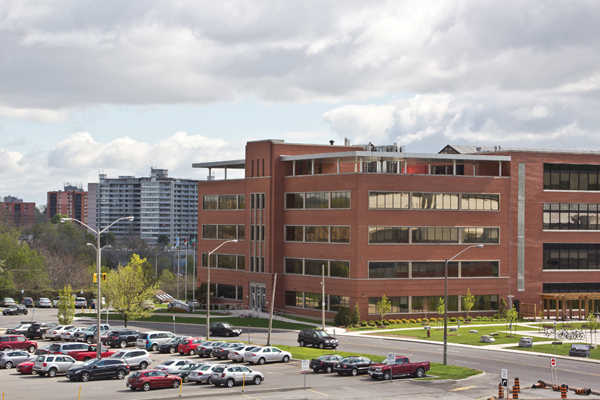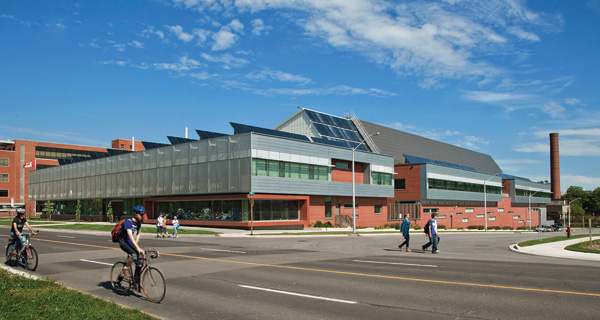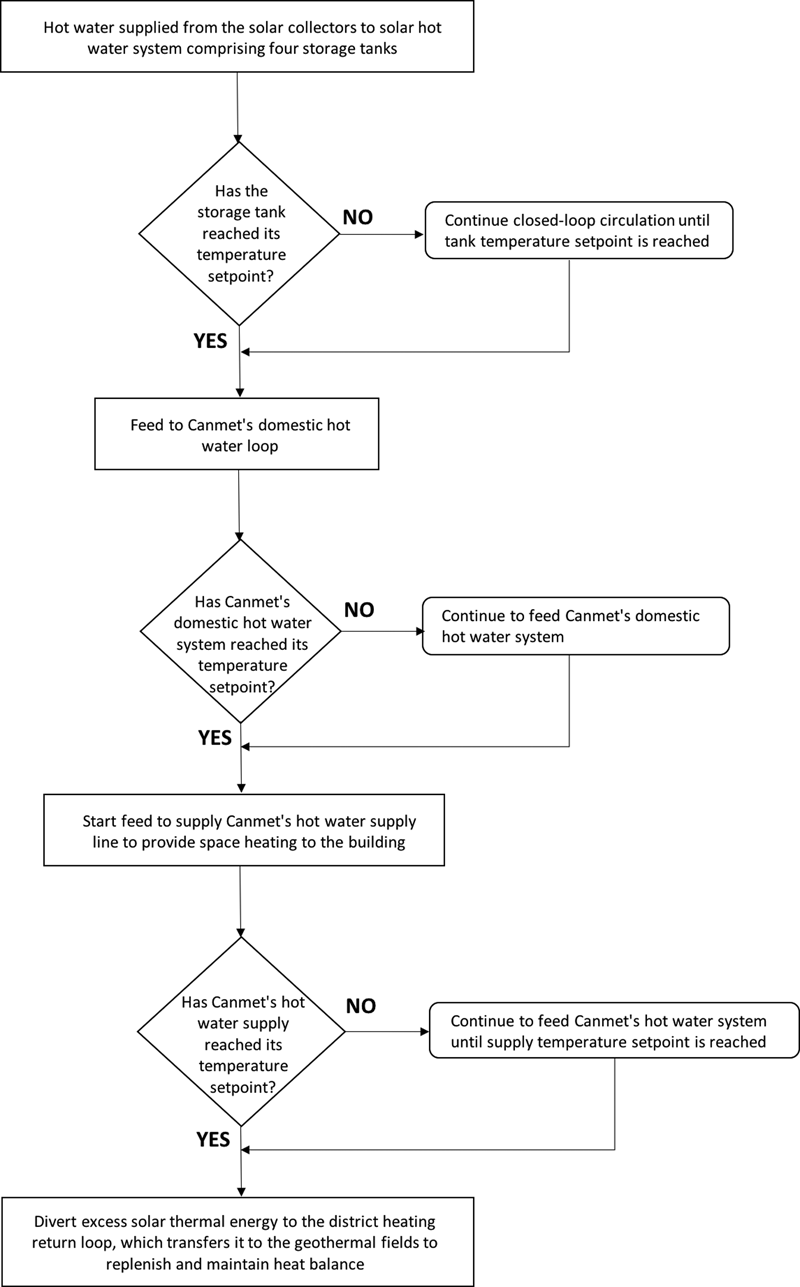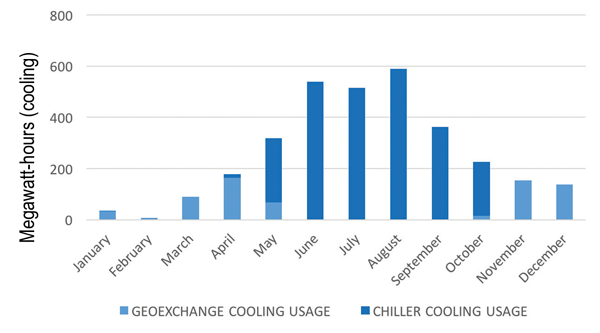By Ankur Mehrotra, Research Consultant, HCE Energy Inc.
The following article was originally published in District Energy magazine, January 2017. It is reprinted here with permission of the International District Energy Association <www.districtenergy.org>.
McMaster Innovation Park (MIP) is an award-winning, emerging research hub in Hamilton, Ontario, aligned with nearby McMaster University. In the 10 years since the master plan for the park was unveiled, the project has been transforming a 37-acre brownfield site, once home to Westinghouse Camco warehouse and plant facilities, into a place where scientists, researchers, engineers and entrepreneurs turn ideas into commercial opportunities. The redevelopment of this former industrial site into a world-class research park mirrors the transition of Hamilton itself from a manufacturing center into a knowledge-based economy.
 The McMaster Automotive Resource Centre at McMaster Innovation Park. Courtesy McMaster Innovation Park.
Committed to environmental sustainability, MIP plans to have 10 state-of-the-art buildings on site within the next 10 years. All will be required to meet Leadership in Energy and Environmental Design (LEED) Silver or higher certification standards. Three buildings are up and running so far, with plans under way for more construction in the near term.
The McMaster Automotive Resource Centre at McMaster Innovation Park. Courtesy McMaster Innovation Park.
Committed to environmental sustainability, MIP plans to have 10 state-of-the-art buildings on site within the next 10 years. All will be required to meet Leadership in Energy and Environmental Design (LEED) Silver or higher certification standards. Three buildings are up and running so far, with plans under way for more construction in the near term.
In 2009, the park began partnering with HCE Energy Inc. of Hamilton to build a groundbreaking on-site district energy system that would integrate geo-exchange and solar thermal energy resources. It was among the first such systems in Ontario – and is still among a very few in Canada – employing a hybrid of renewable and conventional technologies.
Shared Vision
By the time it teamed up with the innovation park, the municipally-owned HCE Energy had already been operating a clean-burning district energy system in downtown Hamilton since 2002. The downtown system uses a natural gas-fired reciprocating engine coupled with three 4 MW gas-fired boilers at its combined heat and power plant to provide space heating, domestic hot water and backup electricity to more than 2 million square feet of customer buildings.
HCE Energy recognized early on in the development of MIP that the innovation park’s commitment to sustainability lined up with its own vision of energy efficiency. As a result, the company became an early and significant partner in the MIP project. In 2009, it began developing a district energy system to provide space heating, space cooling and domestic hot water to the park. At that time, the first building at the park site – The Atrium@MIP – was already constructed with its own boilers and chillers, which were later re-engineered and incorporated within the district system.
The three MIP buildings completed and connected to date include:
• The Atrium@MIP – a five-story, 186,000-sq-ft office, lab and conference facility that was the first to open in 2009;
• CanmetMATERIALS – a 165,000-sq-ft LEED Platinum building officially opened in 2011 that houses Canada’s largest research center for metals and materials fabrication, processing and evaluation; and
• McMaster Automotive Resource Centre – a 92,000-sq-ft set of university labs, opened in 2013, where students, researchers and industry professionals work to solve automotive issues and design the vehicles of tomorrow.
 The Atrium@MIP, formerly an office and factory for Westinghouse, houses the district energy system boilers, chillers and heat pumps in a basement plant. Courtesy McMaster Innovation Park.
The district energy system designed to serve these and other MIP properties to come comprises the following:
The Atrium@MIP, formerly an office and factory for Westinghouse, houses the district energy system boilers, chillers and heat pumps in a basement plant. Courtesy McMaster Innovation Park.
The district energy system designed to serve these and other MIP properties to come comprises the following:
• A geo-exchange field of 81 500-foot-deep boreholes integrated with four Multi-stack heat pumps, located in the central plant in the Atrium building basement, with a 137 kW capacity in heating mode and a 50-ton capacity in cooling mode
• 12,000 square feet of solar wall at the CanmetMATERIALS building that acts as a huge air duct, heating the air drawn through it via convection
• 208 solar thermal collection panels on the roof of CanmetMATERIALS used for supplying domestic hot water and hot water for space heating, with excess heat used to replenish the geo-exchange fields
• Three 360 kW natural gas-fired hot water boilers and an additional 500 kW condensing boiler, all located at the Atrium plant, to provide conventional backup to the heating loop
• One 300-ton and a 285-ton centrifugal chiller, located at the Atrium plant, to supplement the buildings’ cooling needs.
 The CanmetMATERIALS building is home to 208 solar thermal collection panels and 12,000 sq ft of solar wall that are part of the MIP district heating system. Courtesy McMaster Innovation Park.
The CanmetMATERIALS building is home to 208 solar thermal collection panels and 12,000 sq ft of solar wall that are part of the MIP district heating system. Courtesy McMaster Innovation Park.
Synergy Between Renewable and Non-Renewable Energy
The MIP district heating system combines the geo-exchange, solar thermal and boilers in a cascaded loop to supply space heating and domestic hot water to all the buildings at the park. To supply the heating loads of the buildings, HCE Energy utilizes the four 137 kW heat pumps interfaced with the geo-exchange field in heating mode along with the rooftop solar thermal panels and solar wall installed at the Canmet facility and three 360 kW hot water boilers and the 500 kW condensing boiler in the Atrium central plant. Domestic hot water and heating loads in the Canmet building are served by the solar thermal system first, with incremental heating then supplied by the heat pumps and geofield. Heating peaks and heating supply redundancy are supplied by the conventional hot water boilers.
 Figure 1. Solar thermal loop control strategy, McMaster Innovation Park. Source: HCE Energy Inc.
The flow chart in figure 1 shows how the solar thermal system interfaces with the geo-exchange system and the conventional boilers to satisfy building heating needs. Successful management of the geo-exchange fields requires that the system maintain a heat balance. By transferring excess heat generated from the solar hot water system to the ground, the system achieves the optimal balance. This creates a synergy that provides better coefficients of performance to the system. The ground acts as a heat sink for the excess heat, thereby preventing the geofields from freezing due to heat starvation. The geo-exchange system also runs in cooling mode, supplemented by the two centrifugal chillers operating in a lead-lag mechanism. The geo-exchange system generates the highest efficiencies when operating in a dual mode, i.e., heating and cooling simultaneously during shoulder seasons, with the glycol loop on standby.
Figure 1. Solar thermal loop control strategy, McMaster Innovation Park. Source: HCE Energy Inc.
The flow chart in figure 1 shows how the solar thermal system interfaces with the geo-exchange system and the conventional boilers to satisfy building heating needs. Successful management of the geo-exchange fields requires that the system maintain a heat balance. By transferring excess heat generated from the solar hot water system to the ground, the system achieves the optimal balance. This creates a synergy that provides better coefficients of performance to the system. The ground acts as a heat sink for the excess heat, thereby preventing the geofields from freezing due to heat starvation. The geo-exchange system also runs in cooling mode, supplemented by the two centrifugal chillers operating in a lead-lag mechanism. The geo-exchange system generates the highest efficiencies when operating in a dual mode, i.e., heating and cooling simultaneously during shoulder seasons, with the glycol loop on standby.
An average heating COP of 4.4 is observed during winter months, whereas an average cooling COP of 6.0 is observed during summer months. The shoulder seasons exhibit considerably higher COPs due to dual-mode operation; however, operation in dual mode is comparatively more difficult to control and manage from an operations standpoint. The key is to minimize load on boilers and chillers during the shoulder season to reduce the use of fossil fuels.
Operating Lessons at MIP
In operation now for more than six years (commissioned in late 2010), the district energy system at McMaster Innovation Park is unique for its combination of technologies; and its success is dependent on the interaction of these different technologies and selection of the optimal combination of them.
 Figure 2. Seasonal heating load distribution, McMaster Innovation Park district energy system: Baseload geothermal in summer and shoulder seasons, topped by boilers in winter. Source: HCE Energy Inc.
The operating strategy of the MIP district energy system is to use geo-exchange to maximal advantage by flipping the traditional seasonal modes of operation. The heat pumps supply baseload heating in the summer, minimizing the need for boilers to provide domestic hot water and process heating loads in the CanmetMATERIALS building. During the winter season, geo-exchange operates in cooling mode to provide for dehumidification and process cooling loads, thereby preventing the need to run electric chillers. The shoulder seasons utilize the heat pumps to operate in dual mode (heating and cooling) to maximize efficiency and minimize load on the boilers and chillers. While switching up modes is the strategy that works best for MIP, it may not be for systems with different load dynamics. This operating philosophy is only possible at MIP due to the high process heating and cooling loads required year-round, which help to maintain a near-perfect heat balance within the geothermal fields during all seasons, as shown in figures 2 and 3.
Figure 2. Seasonal heating load distribution, McMaster Innovation Park district energy system: Baseload geothermal in summer and shoulder seasons, topped by boilers in winter. Source: HCE Energy Inc.
The operating strategy of the MIP district energy system is to use geo-exchange to maximal advantage by flipping the traditional seasonal modes of operation. The heat pumps supply baseload heating in the summer, minimizing the need for boilers to provide domestic hot water and process heating loads in the CanmetMATERIALS building. During the winter season, geo-exchange operates in cooling mode to provide for dehumidification and process cooling loads, thereby preventing the need to run electric chillers. The shoulder seasons utilize the heat pumps to operate in dual mode (heating and cooling) to maximize efficiency and minimize load on the boilers and chillers. While switching up modes is the strategy that works best for MIP, it may not be for systems with different load dynamics. This operating philosophy is only possible at MIP due to the high process heating and cooling loads required year-round, which help to maintain a near-perfect heat balance within the geothermal fields during all seasons, as shown in figures 2 and 3.
 Figure 3. Seasonal cooling load distribution, McMaster Innovation Park district energy system: Geothermal for process cooling in winter, chiller operations in summer, dual mode in shoulder seasons. Source: HCE Energy Inc.
To complement this system, the air-handling units within each building need to be larger in size than a conventional high-temperature thermal source to provide the required heat transfer and return temperatures, as the geo-exchange system has a supply temperature threshold of approximately 55 degrees C (131 F) for heating. Larger air handlers increase the surface area for heat exchange and allow for operation at lower temperatures compared to AHUs utilizing conventional-technology, typically 95 C (203 F).
Figure 3. Seasonal cooling load distribution, McMaster Innovation Park district energy system: Geothermal for process cooling in winter, chiller operations in summer, dual mode in shoulder seasons. Source: HCE Energy Inc.
To complement this system, the air-handling units within each building need to be larger in size than a conventional high-temperature thermal source to provide the required heat transfer and return temperatures, as the geo-exchange system has a supply temperature threshold of approximately 55 degrees C (131 F) for heating. Larger air handlers increase the surface area for heat exchange and allow for operation at lower temperatures compared to AHUs utilizing conventional-technology, typically 95 C (203 F).
This also permits the use of a more efficient condensing boiler. In order for a condensing boiler to work efficiently, the return temperatures should be lower than the stack temperatures. Condensing boilers recover heat energy from the exhaust gases that would otherwise be released into the atmosphere through the flue. In order to use this latent heat, the water vapor present in the exhaust gases is turned into liquid condensate. For maximum utilization of this latent heat, the return temperatures should be well below the dew point, as shown in figure 4. The efficiency increases exponentially, showing that the ideal condensing range is below 55 C (131 F), which fits in perfectly with the lower return temperatures associated with a geo-exchange system.
 Figure 4. Condensing boiler operating range and efficiencies, McMaster Innovation Park. Source: HCE Energy Inc.
Because of the synergy created by using geo-exchange along with a condensing boiler – both favorable to operate at lower temperatures – there is an option to use cross-linked polyethylene tubing (PEX) in the supply piping. Flexible PEX tubing is cheaper to install than rigid metal piping and has several advantages over conventional steel pipe, including fewer fittings requirements, the ability to turn 90-degree corners without using elbow fittings and the ability to be installed in long runs without needing coupling fittings. The costs incurred by installing larger AHUs can be offset by savings generated from using PEX piping, which is more reliable and easier to install and maintain than conventional steel piping.
Figure 4. Condensing boiler operating range and efficiencies, McMaster Innovation Park. Source: HCE Energy Inc.
Because of the synergy created by using geo-exchange along with a condensing boiler – both favorable to operate at lower temperatures – there is an option to use cross-linked polyethylene tubing (PEX) in the supply piping. Flexible PEX tubing is cheaper to install than rigid metal piping and has several advantages over conventional steel pipe, including fewer fittings requirements, the ability to turn 90-degree corners without using elbow fittings and the ability to be installed in long runs without needing coupling fittings. The costs incurred by installing larger AHUs can be offset by savings generated from using PEX piping, which is more reliable and easier to install and maintain than conventional steel piping.
These systems are supplemented by the solar hot water system that meets the Canmet building’s domestic hot water demand and supplies excess thermal energy to the ground. As mentioned earlier, the geo-exchange fields act as a heat sink, where energy can be stored for use at a later date. The field acts as a seasonal storage for thermal energy and prevents the geofields from freezing.
Another striking feature of the geo-exchange system is that it is aesthetically pleasing: Having 81 geothermal wells on-site could have been visually unappealing for the park, but the wells have been very well concealed under a grassy park behind the Atrium building, enhancing the green space in the area.
Path Toward a Carbon-Neutral Future
McMaster Innovation Park showcases the transformation of a contaminated former industrial site into a premier research institute, winning awards in the process for its sustainable and innovative design. The CanmetMATERIALS building, for example, has been honored by the Canada Green Building Council and the American Institute of Architects, while The Atrium@MIP received a city of Hamilton award for urban design and architecture.
The park is currently in full growth mode. At present, MIP is preparing to open the Centre for Biomedical Engineering and Advanced Manufacturing later this year in an existing 40,000 sq.ft. warehouse attached to the McMaster Automotive Resource Centre. Plans are also in development for a new Emerging Technology Centre with 80,000 square feet of lab, incubator and meeting space.
With this growth comes the need to expand the district energy system. Given MIP’s commitment to sustainability, HCE Energy is considering multiple sustainable and cost-effective options that would also limit the carbon footprint of the innovation park. With a grant from the Federation of Canadian Municipalities’ Green Municipal Fund, HCE Energy has been studying the feasibility of incorporating various state-of-the-art renewable technologies including, but not limited to, solar thermal-powered absorption chillers, solar photovoltaics-driven electrical chillers and a CHP option creating a microgrid.
The future of energy demands lower dependence on fossil fuels and greener alternatives to supply energy to buildings. As demonstrated at McMaster Innovation Park, district energy is versatile enough to be able to incorporate a variety of sustainable technologies as the situation demands. In Hamilton and elsewhere, district energy is magnificently paving a path toward a carbon-neutral future as communities and municipalities collaborate for the betterment of the entire planet.
 Author Ankur Mehrotra.jpg
Ankur Mehrotra is a researcher in the engineering department at district energy provider HCE Energy Inc. in Hamilton, Ont. He is an engineering design postgraduate from the W. Booth School of Engineering Practice at McMaster University specializing in process and production systems. He also holds a Bachelor of Technology degree in petroleum engineering from the University of Petroleum & Energy Studies, India. Mehrotra gained valuable hands-on experience in the oil and gas industry before making a switch to the field of district energy services, where he continues to work on sustainable and renewable energy technologies. HCE Energy is a Hamilton Utilities Corporation company. Mr. Mehrotra can be reached at
Author Ankur Mehrotra.jpg
Ankur Mehrotra is a researcher in the engineering department at district energy provider HCE Energy Inc. in Hamilton, Ont. He is an engineering design postgraduate from the W. Booth School of Engineering Practice at McMaster University specializing in process and production systems. He also holds a Bachelor of Technology degree in petroleum engineering from the University of Petroleum & Energy Studies, India. Mehrotra gained valuable hands-on experience in the oil and gas industry before making a switch to the field of district energy services, where he continues to work on sustainable and renewable energy technologies. HCE Energy is a Hamilton Utilities Corporation company. Mr. Mehrotra can be reached at
